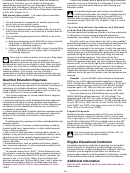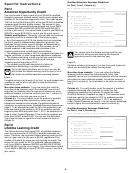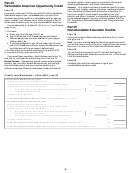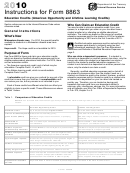Instructions For Form 8863 - Education Credits (American Opportunity And Lifetime Learning Credits) - 2010
ADVERTISEMENT
2010
Department of the Treasury
Internal Revenue Service
Instructions for Form 8863
Education Credits (American Opportunity and Lifetime Learning Credits)
You may be able to take the tuition and fees deduction
Section references are to the Internal Revenue Code unless
for you, your spouse, or a dependent, instead of an
otherwise noted.
TIP
education credit. Figure your tax both ways and choose
General Instructions
the one that gives you the lower tax. See Form 8917, Tuition
and Fees Deduction, and chapter 6 of Pub. 970, Tax Benefits
for Education, for more information about the tuition and fees
What’s New
deduction.
Midwestern disaster area. For 2010, the special benefits
Who Can Claim an Education Credit
available to students in a Midwestern disaster area have
expired.
You may be able to claim an education credit if you, your
spouse, or a dependent you claim on your tax return was a
Hope credit. The Hope credit is not available for 2010.
student enrolled at or attending an eligible educational
institution. The credits are based on the amount of qualified
Purpose of Form
education expenses paid for the student in 2010 for academic
periods beginning in 2010 and in the first 3 months of 2011.
Use Form 8863 to figure and claim your education credits,
which are based on qualified education expenses paid to an
Qualified education expenses must be reduced by any
eligible postsecondary educational institution. For 2010, there
!
expenses paid directly or indirectly using tax-free
are two education credits.
educational assistance. See Tax-Free Educational
CAUTION
•
The American opportunity credit, part of which may be
Assistance and Refunds of Qualified Education Expenses on
refundable. Complete Parts I, III, and IV.
page 2.
•
The lifetime learning credit, which is nonrefundable.
Who can claim a dependent’s expenses. If a student is
Complete Parts II and IV.
claimed as a dependent on another person’s tax return, only the
person who claims the student as a dependent can claim a
A refundable credit can give you a refund for any part of the
credit for the student’s qualified education expenses. If a
credit that is more than your total tax. A nonrefundable credit
student is not claimed as a dependent on another person’s tax
can reduce your tax, but any excess is not refunded to you.
return, only the student can claim a credit.
Generally, qualified education expenses paid on behalf of
Both of these credits have different rules that can affect your
the student by someone other than the student (such as a
eligibility to claim a specific credit. These differences are shown
relative) are treated as paid by the student. However, qualified
in Table 1 below.
education expenses paid (or treated as paid) by a student who
Table 1. Comparison of Education Credits
Caution. You can claim both the American opportunity credit and the lifetime learning credit on the same return — but not for the same
student.
American Opportunity Credit
Lifetime Learning Credit
Maximum credit
Up to $2,500 credit per eligible student
Up to $2,000 credit per return
Limit on modified adjusted $180,000 if married filling jointly;
$120,000 if married filling jointly;
gross income (MAGI)
$90,000 if single, head of household, or qualifying
$60,000 if single, head of household, or qualifying
widow(er)
widow(er)
Refundable or
40% of credit may be refundable; the rest is
Nonrefundable — credit limited to the amount of tax you
nonrefundable
nonrefundable
must pay on your taxable income
Number of years of
Available ONLY for the first 4 years of postsecondary
Available for all years of postsecondary education and for
postsecondary education
education
courses to acquire or improve job skills
Number of tax years credit Available ONLY for 4 tax years per eligible student
Available for an unlimited number of years
available
(including any year(s) Hope credit was claimed)
Type of degree required
Student must be pursuing an undergraduate degree or
Student does not need to be pursuing a degree or other
other recognized education credential
recognized education credential
Number of courses
Student must be enrolled at least half time for at least
Available for one or more courses
one academic period beginning during the year
Felony drug conviction
No felony drug convictions on student’s records
Felony drug convictions are permitted
Qualified expenses
Tuition and required enrollment fees. Course-related
Tuition and required enrollment fees (including amounts
books, supplies, and equipment do not need to be
required to be paid to the institution for course-related
purchased from the institution in order to qualify.
books, supplies, and equipment).
Payments for academic
Payments made in 2010 for academic periods beginning in 2010 and in the first 3 months of 2011
periods
Cat. No. 53002G
ADVERTISEMENT
0 votes
Related Articles
Related forms
Related Categories
Parent category: Financial
 1
1 2
2 3
3 4
4








